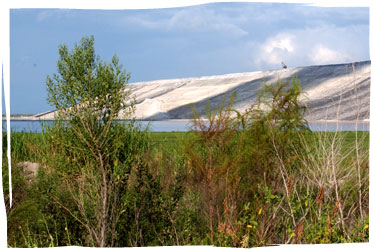Health Risks

Mountainous gypsum stacks such as this one are a common sight along the central Florida landscape. The radioactive material used to be buried too far beneath the ground to be a health risk.
Phosphate has been mined in Florida for more than 100 years. We've known that phosphate rock is radioactive for nearly as long. But, scientific study of the potential health problems associated with phosphate mining is relatively recent.
Florida's soils have naturally occurring radioactivity. For the most part, it's buried well below ground and has little to no effect on the health of plants, animals or people in the ecosystem. The mining process takes what's underground (soils and clays) and puts it at the surface. In doing so, some of the radioactive elements that were buried underground are exposed.
There are two key areas of concern for impacts to public health. The first is whether the radioactive elements can get into water supplies, be released to the air, absorbed into the skin or accumulated in fish or animals. The second concern is what happens when the radioactive particles, such as radium and thorium, are concentrated in the clay settling ponds.
The science on this is contradictory. Most scientists recognize that exposure to radioactive particles in water or air can cause cancer. Still, medical researchers and environmental researchers don't agree on the risks and links between phosphate strip mining and cancer. There's also a difference between what industry researchers and others say.
For example, a 1985 study from the Florida Institute for Phosphate Research concluded that the risk from inhaling odorless, tasteless radon vapors coming from the water is greater than if you ingest the particles. They also concluded that public water supplies and surface water are at no risk.
But, in 1995 a phosphate gypsum stack collapsed into a sinkhole in Hillsborough County. Public health officials were concerned about the potential effects of the toxic and radioactive gypsum and its byproducts on groundwater supplies. However, with a two million cubic foot hole in the ground, there was little to be done-except measure and monitor the consequences.
At the time, a University of South Florida professor of medicine and epidemiology expressed his own concerns about the long-term health threats from the high levels of radon gas in homes built on reclaimed phosphate land. He was also concerned about the public's exposure to water and air carrying the particles, chemicals and by-products of phosphate mining.
The problem is this: we know that there is no totally harmless level of radiation and that exposure is cumulative. We don't really understand the relationship between phosphate strip mining and the release of these materials into the environment. Because of that, we don't know how that exposure might affect the plants, animals and people who make the Peace River watershed their home. It's just one more phosphate mining risk.